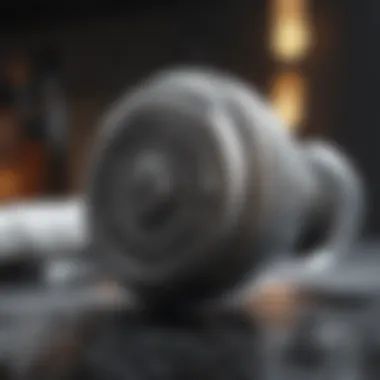Crafting Safe At-Home Douche Solutions


Intro
At-home douche solutions have gained attention over the years as part of personal hygiene practices. While many individuals consider them for various reasons, understanding their formulation and use is essential. The goal is not just to create a solution, but to do so safely and effectively. This article aims to explore the various ingredients commonly used in at-home douches, discuss their potential benefits and risks, and emphasize the importance of informed choices in personal care.
Research Highlights
Key Findings
Research indicates that the use of at-home douches may impact vaginal health. While some solutions claim to enhance cleanliness or refreshment, they may disrupt the natural flora. Ingredients like vinegar and baking soda are often highlighted in various formulations. However, their effectiveness, as well as potential drawbacks, requires careful consideration.
- Vinegar can help maintain pH balance, but its overuse may lead to irritation.
- Baking soda, while effective for odor control, could alter important bacterial populations.
- Herbal solutions often include chamomile or calendula, which might have soothing properties but lack scientific backing.
- Water-based solutions are generally safer, but they provide little additional benefits beyond rinsing.
By understanding these findings, potential users can make better decisions regarding their hygiene routines.
Implications and Applications
The implications of using at-home douches extend beyond mere cleanliness. They touch on aspects of health, psychology, and cultural norms. Understanding these elements is crucial for promoting safer practices. For instance, educating individuals about the potential for bacterial imbalance can help mitigate health issues.
Methodology Overview
Research Design
This article investigates the formulation of at-home douches by reviewing current scientific literature and anecdotal evidence. It aims to compile findings from diverse sources to provide a comprehensive overview.
Experimental Procedures
The examination of different formulations involved analyzing common household ingredients and their traditional uses in douching practices. Surveys and expert opinions were gathered to assess attitudes towards at-home solutions. This approach allows for a more rounded understanding of preferences and health outcomes relevant to douching.
This comprehensive guide intends to empower readers by creating informed decisions about their health and hygiene practices.
Understanding the Concept of Douche Solutions
Douching is a process that involves rinsing the vagina with water or other solutions. It has been a frequent subject of discussion in personal hygiene, with varying opinions on its efficacy and safety. Understanding the concept of douche solutions is crucial for several reasons. First, it informs individuals about the potential benefits and risks involved in this practice. Second, it helps demystify the idea of vaginal cleansing, empowering users to make educated choices about their body.
Definition and Historical Context
Douching, as defined, refers to the act of flushing or cleaning the vagina with a liquid solution. The term 'douche' itself originates from the French word for 'shower.' Historically, women have used various substances for douching, dating back to ancient civilizations. In some cultures, douching was considered essential for maintaining hygiene and preventing disease. Over time, the practice incorporated a range of ingredients, from herbal mixtures to commercial products formulated for vaginal health.
The historical reliance on douching raises important considerations in today's context. Many women were led to believe that douching could clean the vagina, while medical professionals now emphasize that it can disrupt the natural balance of vaginal flora. Understanding this change in perspective provides insight into why at-home douche solutions are part of present discussions.
Purpose of Douching
The primary purpose of douching has traditionally been to promote cleanliness and reduce odor. Women often douch to feel fresher, especially after menstruation or sexual intercourse. Some believe it can help clear infections or alleviate discomfort caused by various conditions. However, the therapeutic use of douching is now questioned by healthcare professionals. Most practitioners advise that the vagina is self-cleaning, relying on its natural mechanisms and secretions.
It’s important to consider why some might still choose to use douching products. Addressing potential discomfort, managing hygiene concerns, and reinforcing feelings of cleanliness can all be driving factors. Yet, understanding the full scope of what douching does—or does not do—can lead to more informed decisions regarding vaginal care.
Components of At-Home Douche Solutions
Understanding the components of at-home douche solutions is essential for those seeking to maintain vaginal health. Each ingredient plays a specific role and contributes to the overall efficacy and safety of the solution. This section discusses three key ingredients: water, vinegar, and baking soda. Their proper use can provide benefits, but it is necessary to be aware of each component's effects.
Preparing the Solution: Best Practices
Preparing an effective at-home douche solution is crucial for ensuring both efficacy and safety. This process involves more than just mixing ingredients; it requires attention to proportions, cleanliness, and the chosen components. Understanding best practices helps minimize risks and maximizes the potential benefits. Without proper preparation, even the simplest of solutions can lead to complications, including irritation or infections. Thus, emphasis on methodology is essential for anyone considering this practice.
Determining Appropriate Ratios


The ratio of ingredients in a douche solution can significantly affect its effectiveness and safety. It is vital to adhere to guidelines that take into account the body’s natural pH levels and the intended purpose of the solution. For instance, a common mix could involve a 1:1 ratio of vinegar to water, which is gentle yet effective in cleansing. On the other hand, using excess vinegar could lead to irritation.
In general, considerations for ratios include:
- The acidity level of the components, which should not exceed a tolerable level for the body.
- The purpose of the douche, such as cleansing or soothing, which dictates the choice of ingredients.
- Any personal sensitivities or medical conditions that may require adjusted ratios.
Thus, careful measurement is a key component of safe preparation.
Sterilizing Equipment
Sterilization of equipment is an often overlooked aspect of preparing a douche solution. Without proper sanitation, there is a high risk of introducing bacteria, which could lead to infections or other complications. Ensure that all tools, including syringes or irrigation bottles, are cleaned thoroughly using boiling water or medical-grade disinfectants.
Some key practices include:
- Cleaning: Wash all equipment with soap and hot water before every use.
- Boiling: Submerge the tools in boiling water for at least 10 minutes to kill pathogens.
- Drying: Allow equipment to air dry on a clean surface, avoiding the risk of contamination from towels or cloths.
"Even the best solutions can cause harm if not applied with sanitized tools."
Following these sterilization practices ensures that the solution remains uncontaminated, providing a safer experience for users.
Adhering to these best practices—especially regarding ratios and sterilization—will lead to a more effective and safer at-home douching experience.
Administration Techniques
The administration technique is a critical aspect of using at-home douche solutions effectively. Many individuals overlook this factor, which can lead to ineffective cleaning, discomfort, or even health issues. Understanding various techniques ensures safer practices and better outcomes. It involves proper positioning of the body and effective methods of application.
Selecting the Right Position
Choosing the right position is essential for the effectiveness of an at-home douche. The position can determine how well the solution reaches the desired area. Here are some common options:
- Standing: This is often considered ineffective as gravity does not assist in the process.
- Sitting on the toilet: This position provides some benefits, allowing for less mess and easier post-application clean-up.
- Lying down: In this position, the body can relax and allows a more thorough cleansing effect. It is generally preferred by many for its effectiveness.
Considerations when selecting a position:
- Comfort during the process is key.
- Avoid positions that put strain on the body or cause discomfort.
- Consider the direction of the flow of the solution and how gravity affects it.
*Choosing the right position minimizes discomfort and enhances effectiveness of the douching process.
Proper Application Methods
Proper application methods refer to how the douche solution is introduced into the body. This step directly impacts the experience and the outcome. Here are a few techniques:
- Gentle Insertion: The nozzle of the douche should be inserted gently to avoid injury or irritation. A steady hand and slow motion help ensure comfort.
- Controlled Flow: Regulating the flow of the solution is crucial. Too fast or forceful flow can cause discomfort and is less effective. A slow, steady application is recommended.
- Timing: The duration of application also matters. The process should not be rushed. Allow enough time for the solution to cleanse appropriately without overstaying which may lead to discomfort.
Best practices:
- Always follow the instructions that come with the douche product, if available.
- If there are any signs of irritation or unusual symptoms, it is crucial to stop immediately and consult a healthcare provider.
- Maintain a clean and sterile environment to minimize risks.
Following these guidelines will enhance the experience, increase comfort, and support effective hygiene practices.
Potential Benefits of Douching
Exploring potential benefits of douching offers insight into practices that some individuals still consider for personal hygiene. While medical professionals often advise caution, there are specific contexts where douching may serve certain functions. Here, we will delve into hygienic considerations and managing odor and discomfort as key aspects of the potential benefits associated with at-home douching solutions.
Hygienic Considerations
Douching may provide a sense of cleanliness, particularly after menstruation or sexual activity. This psychological benefit can enhance feelings of freshness and comfort. Some individuals believe that douching helps to remove bodily fluids and debris from inside the vagina, which could promote a sense of well-being. However, it is crucial to recognize that the vaginal environment is self-regulating, primarily through natural secretions that keep it clean.


Despite these beliefs, some studies suggest that excessive douching can lead to negative outcomes. For instance, disruption of the natural vaginal flora can increase chances of developing infections. Therefore, while the goal of achieving cleanliness is understandable, moderation and awareness of personal health are vital.
Managing Odor and Discomfort
Another commonly cited benefit of douching is the management of odor and discomfort. Some people experience odor due to various reasons, such as menstruation or bodily changes. In such cases, a gentle douche solution may temporarily mask or alleviate these odors.
However, it is essential to consider alternative remedies that do not disturb the balance of beneficial bacteria. Additionally, discomfort in the vaginal area can arise from conditions that douching might not address. Proper consultation with a healthcare provider is advisable for persistent issues.
Risks and Controversies Associated with Douching
The subject of douching elicits much debate in health circles. It's important to scrutinize the potential risks and ongoing controversies surrounding this practice. While some may pursue at-home douching solutions for various reasons, understanding the consequences is crucial.
Disruption of Vaginal Flora
The vagina is home to a delicate ecosystem of bacteria, mainly Lactobacillus, which helps maintain pH balance and prevent infections. Douching can disturb this natural flora. Studies show that altering the vaginal environment increases susceptibility to infections, such as bacterial vaginosis and yeast infections. Not only does douching remove beneficial bacteria, but it also changes the acidity levels of the vagina.
Regular douching can lead to a cycle of irritation and imbalance. Consequently, women may find themselves trapped in a loop of using douches to address symptoms caused by their initial use.
It's imperative to recognize that the vagina is self-cleaning. The body's mechanisms for maintaining cleanliness often function better without external interventions like douching.
Link to Health Issues
Some research correlates douching with more severe health problems. For example, women who douche regularly may be at greater risk for pelvic inflammatory disease. This condition can lead to complications, including infertility and chronic pelvic pain.
Researchers have also studied potential links between douching and cervical cancer. While findings vary, douching is generally viewed as a behavior that could introduce harmful bacteria. Therefore, the risk is plausible.
Health professionals recommend moderation. Caution is advised, especially for individuals with a history of reproductive health issues.
Informed Choices Are Crucial: Understanding the implications of douching is vital for personal health. It is advisable to consult a healthcare professional before making decisions about douching or using home remedies.
Alternatives to Traditional Douching
Exploring alternatives to traditional douching is crucial for those looking for effective yet safer methods of personal hygiene. Understanding the potential risks of douching can lead to more informed choices. There are various options available that can maintain cleanliness without disrupting the natural balance of vaginal flora.
Gentle cleaning solutions and natural remedies are among these alternatives. They allow individuals to achieve desired hygiene outcomes while minimizing potential health issues associated with douching. Choosing these alternatives can also lead to a more holistic approach to personal care, focusing on maintaining the body's natural functions.
Gentle Cleaning Solutions
Gentle cleaning solutions provide a basic yet effective method to support hygiene without the risks tied to traditional douching. Mild, pH-balanced cleansers are often recommended. They help to clean the external genital area without disrupting the natural vaginal environment. Here are some key points regarding their use:
- pH Balance: Using a cleanser formulated to match the body's natural pH can help sustain the delicate acid balance in the vagina.
- Fragrance-Free Options: Fragrance can irritate sensitive tissues. Selecting odorless products helps avoid unnecessary discomfort.
- Water as a Base: Rinsing with warm water can be an effective method for external cleansing. It hydrates the skin without the addition of harmful substances.
“A gentle approach respects the body’s natural chemistry, promoting health and cleanliness.”
Before using any cleansing solution, it is advisable to patch-test on a small area to ensure no adverse reaction occurs.
Natural Remedies
Natural remedies often appeal to those seeking alternatives rooted in traditional practices or natural ingredients. These remedies can provide gentle, effective solutions for vaginal hygiene. Here are some natural options to consider:
- Coconut Oil: Known for its antimicrobial properties, coconut oil can be used externally to provide moisture and prevent irritation.
- Aloe Vera Gel: This soothing plant extract can ease discomfort and promote healing when applied to the external area.
- Chamomile Tea: A diluted chamomile tea rinse can serve as a natural anti-inflammatory agent, potentially calming irritation when applied cautiously.
When incorporating natural remedies, it is essential to research their uses and understand potential allergies. Each individual's needs may vary, and consulting a healthcare professional before application is always prudent.
Overall, exploring alternatives to traditional douching can lead to safer and more effective personal hygiene practices.
Scientific Perspectives on Douching


The scientific perspective on douching is essential in understanding both its potential benefits and inherent risks. It emphasizes evidence-based practices and sheds light on the validity of traditional beliefs surrounding personal hygiene. Research plays a crucial role in determining the safety and efficacy of at-home douche solutions. By reviewing the current literature and professional recommendations, one can navigate the complex landscape of vaginal health.
Review of Current Research
Current research on douching suggests a complex interaction between douching practices and vaginal health. Studies indicate that while some individuals believe douching may support hygiene, it can disturb the natural flora of the vagina. This disruption can lead to various health issues, including bacterial vaginosis and yeast infections. A notable study published in the Journal of Women's Health highlighted a correlation between douching frequency and incidents of pelvic inflammatory disease.
Moreover, a review in the American Journal of Obstetrics and Gynecology underscored that douching is often associated with a higher risk of sexually transmitted infections. It's important to note that health professionals typically recommend a minimal need for invasive hygiene practices. The key findings can be summarized as follows:
- Natural Flora Disruption: Regular douching can impact the balance of healthy bacteria.
- Increased Infection Risk: There is a documented relationship between douching and susceptibility to infections.
- Misconceptions: Despite prevalent beliefs, douching may not be necessary for maintaining vaginal hygiene.
Recommendations from Health Professionals
Health professionals generally approach the topic of douching with caution. Many recommend abstaining from douching altogether. The prevailing advice is to maintain internal hygiene using water and mild soaps only on the external area. Additionally, experts underline the importance of paying attention to bodily signals. Symptoms like unusual odor or discharge should prompt a visit to a healthcare provider, rather than self-treatment with douching.
Key recommendations include:
- Avoid Douching: It is often advised against for routine hygiene.
- Consult Healthcare Providers: For any concerns regarding vaginal health, professional advice is critical.
- Proactive Health Monitoring: Being attentive to personal health and symptoms is paramount.
"The natural balance of vaginal flora should be respected. Douching disrupts that balance and poses unnecessary risks." - Vaginal Health Research Group
Cultural Attitudes Towards Douching
Understanding cultural attitudes towards douching is essential in the discussion of at-home douche solutions. Societal norms, beliefs, and historical practices shape how individuals perceive personal hygiene and douching in particular. This section aims to provide a comprehensive insight into the influences that direct people’s choices regarding douching and establish a contextual framework.
Historical Practices Across Cultures
Historically, douching has been a practice found in various cultures with diverse methods and ingredients used. Ancient Egyptian women, for example, often used solutions that included vinegar and honey, reflecting their understanding of cleanliness and personal care. In many indigenous cultures, natural herbs and plants were essential components, believed to provide health benefits beyond mere hygiene.
In Europe, particularly during the Roman Empire, personal cleanliness was highly valued. People would commonly use water and other solutions for douching as part of their bathing rituals. Still, these practices were entwined with beliefs surrounding gender roles and morality. Over centuries, as concepts of modesty evolved, douching became associated with maintaining femininity and purity, particularly in Victorian societies.
Many cultures have also tied specific religious or spiritual meanings to the act of douching, often using it in conjunction with rituals of cleanliness or preparation for important events. This historical background provides essential insights into why douching is viewed variably in contemporary society.
Modern Perceptions and Trends
In modern times, perceptions of douching have shifted significantly. While some individuals continue to uphold traditional views, others question its necessity and safety. The rise of feminism and body positivity movements promotes a more nuanced understanding of personal hygiene, pushing against the stigmas often associated with feminine hygiene practices.
Social media platforms like Reddit and Facebook serve as avenues for discussion and education, allowing for a more diverse exchange of information. Many individuals now look for alternatives to traditional douching, seeking out solutions that align more with contemporary views on body autonomy and respect.
However, not all discussions are positively framed. There are ongoing concerns related to the health implications of douching, leading to a backlash among health professionals.
The dialogue around at-home douching solutions continues to evolve, reflecting broader changes in societal attitudes towards women's health and self-care.
"Cultural beliefs heavily influence hygiene practices, including douching. Understanding these influences can improve approaches to education on safe practices."
In sum, examining cultural attitudes toward douching reveals much about societal norms and health perceptions. Historical antecedents significantly shape modern views, affecting the decisions individuals make regarding their health and hygiene. This understanding is crucial for developing effective educational strategies addressing safe practices in at-home douche solutions.
Ending: Informed Decision-Making
In the realm of personal hygiene, the decision to engage in douching should not be taken lightly. This guide has illuminated the various aspects related to at-home douche solutions. It is imperative to acknowledge the dual nature of douching—on one side, there are potential benefits related to hygiene and comfort; on the other, there are notable risks that may outweigh those benefits.
Understanding both components can lead to more informed decisions. By being aware of the ingredients commonly used, such as vinegar and baking soda, and how they interact within the vaginal environment, individuals can make decisions that align with both their health needs and personal values.
The importance of consulting with healthcare professionals about such practices cannot be understated. Misconceptions abound, often driven by cultural narratives rather than scientific evidence. Therefore, an informed approach can mitigate the risks associated with douching, allowing for a more tailored personal care regimen that prioritizes health.
Summarizing Key Points
- Douche solutions can vary widely in their composition, with common ingredients including water, vinegar, and baking soda. Each has unique properties that can impact vaginal health differently.
- Douching may provide a sense of cleanliness for some, yet it can also disrupt the natural flora that is essential for maintaining vaginal health.
- Consultation with healthcare providers is vital. Professional advice can guide individuals toward safer practices or alternatives suitable for their specific situations.
- Cultural attitudes toward douching have evolved. Modern perspectives are increasingly cautious, emphasizing education and informed choices over conventional practices.
Encouraging Research and Consultation
For those interested in douching or assessing their personal hygiene practices, ongoing research is fundamental. Gathering information from credible sources such as medical journals, reputable health websites, and expert opinions can provide a clearer understanding of the risks and benefits involved. Engaging with necessary resources helps to ensure decisions are grounded in the latest findings and authoritative guidance. Additionally, discussing any doubts or plans with a healthcare professional can further underscore safety and relevance to individual circumstances.
Given the complexities of personal health, empower yourself through thorough research. With mixed messaging surrounding personal care, a proactive stance can lead to healthier choices. By consulting healthcare professionals and remaining apprised of new developments in hygiene practices, individuals can take control of their health with confidence.

